Full text
PDF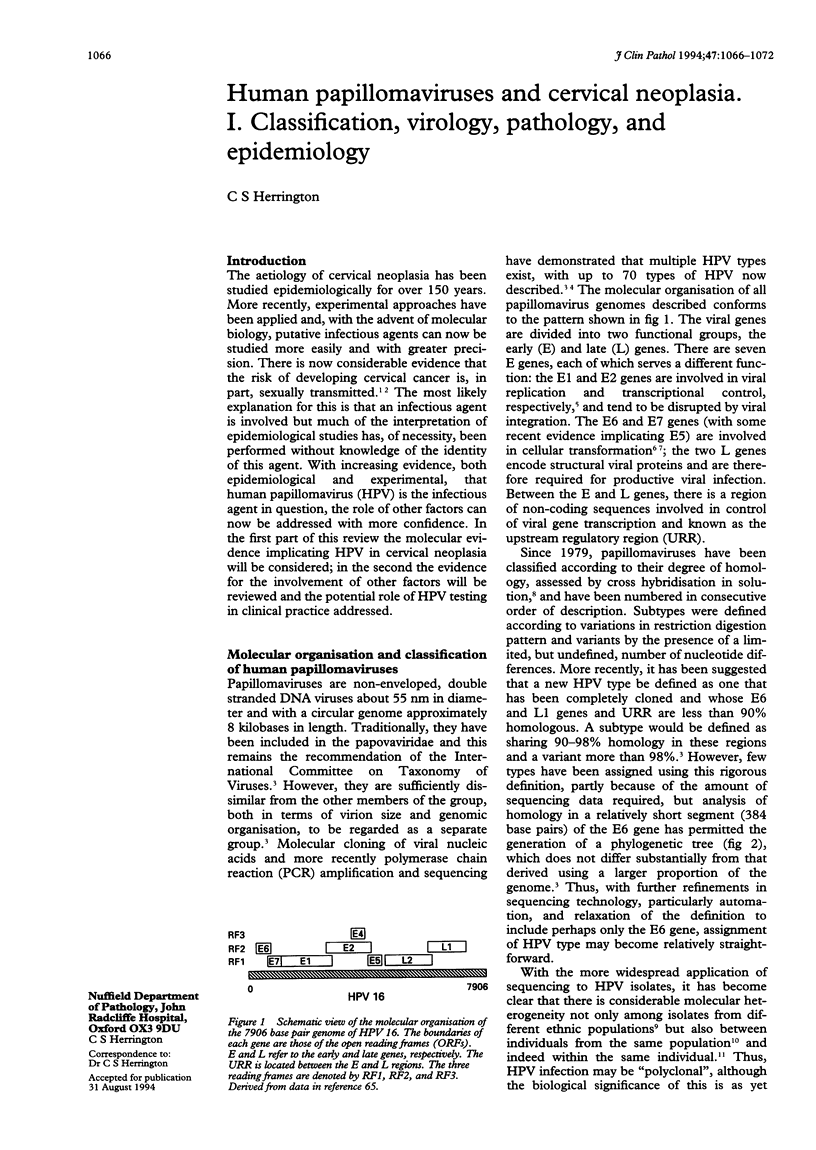
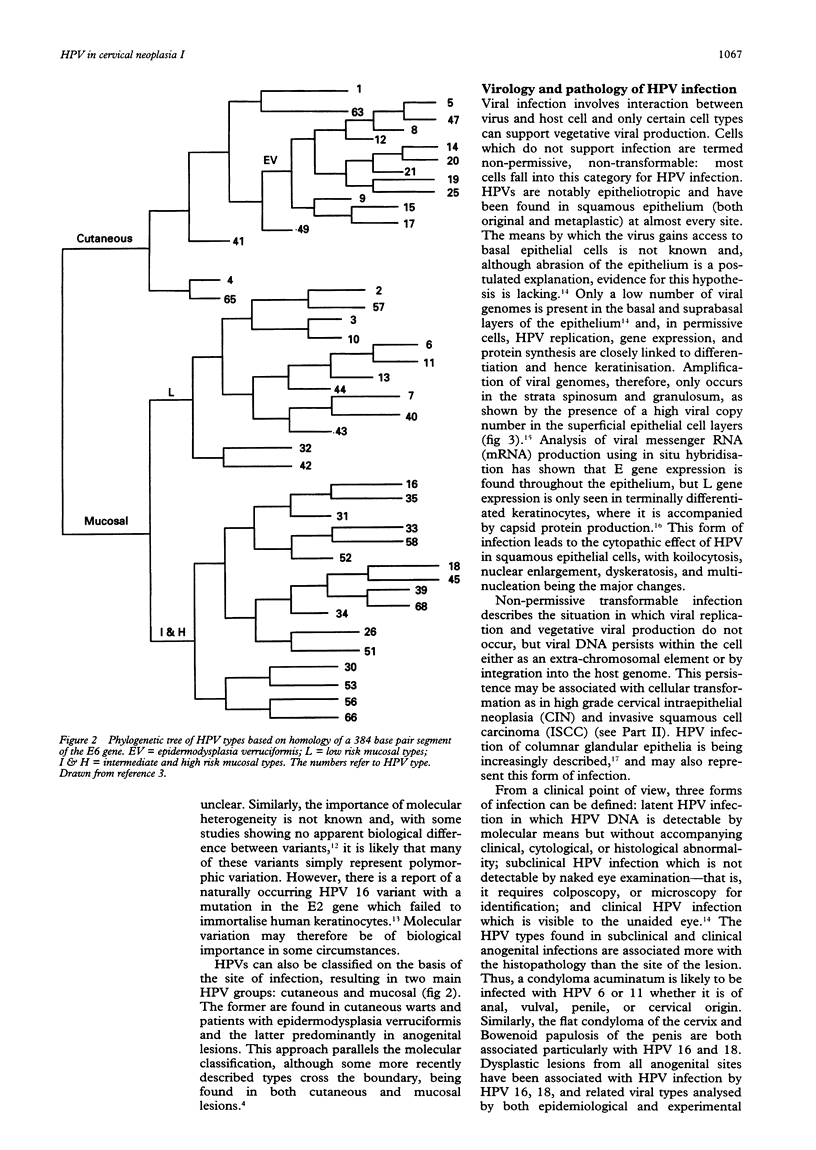
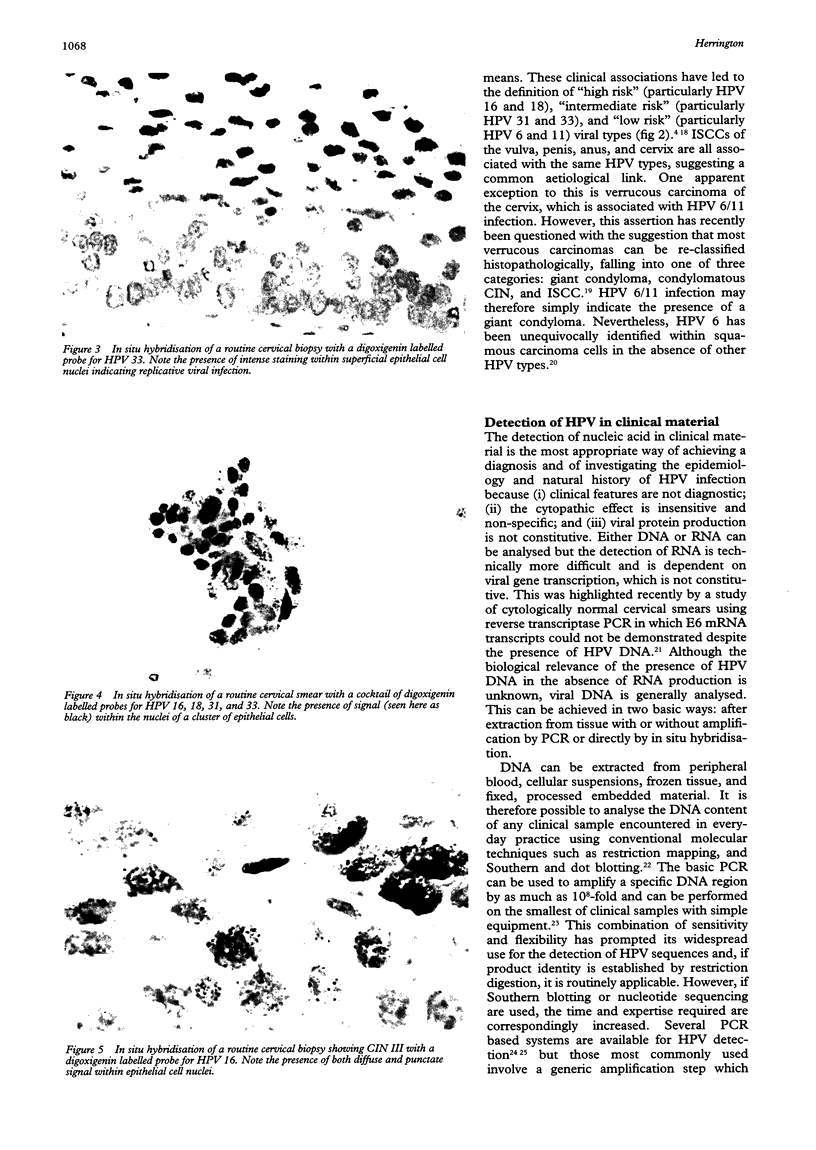

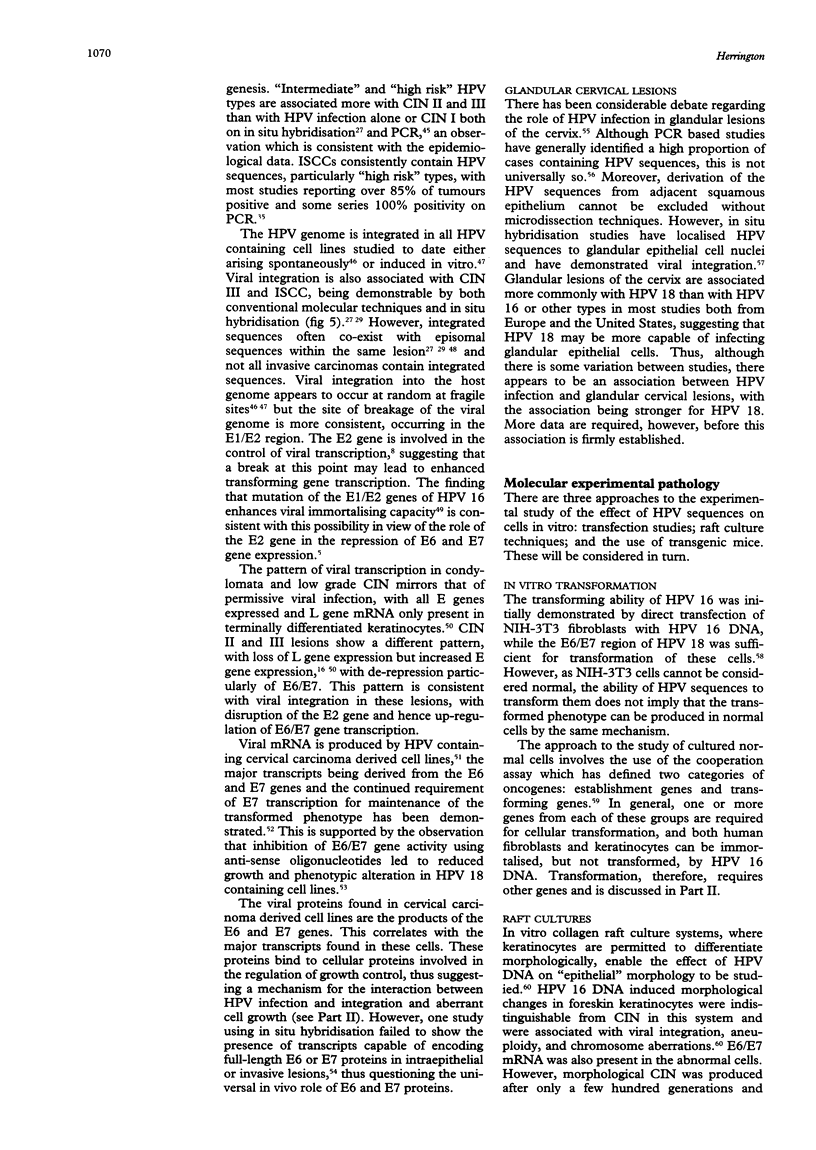
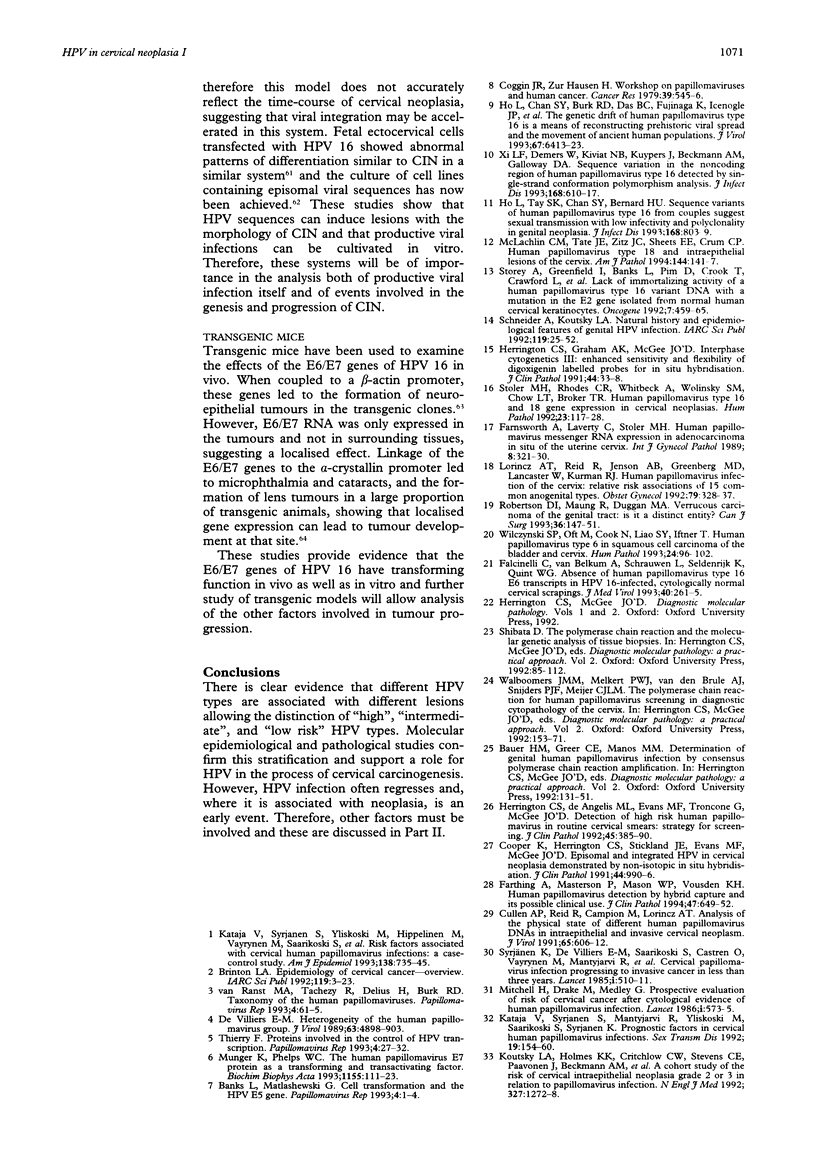
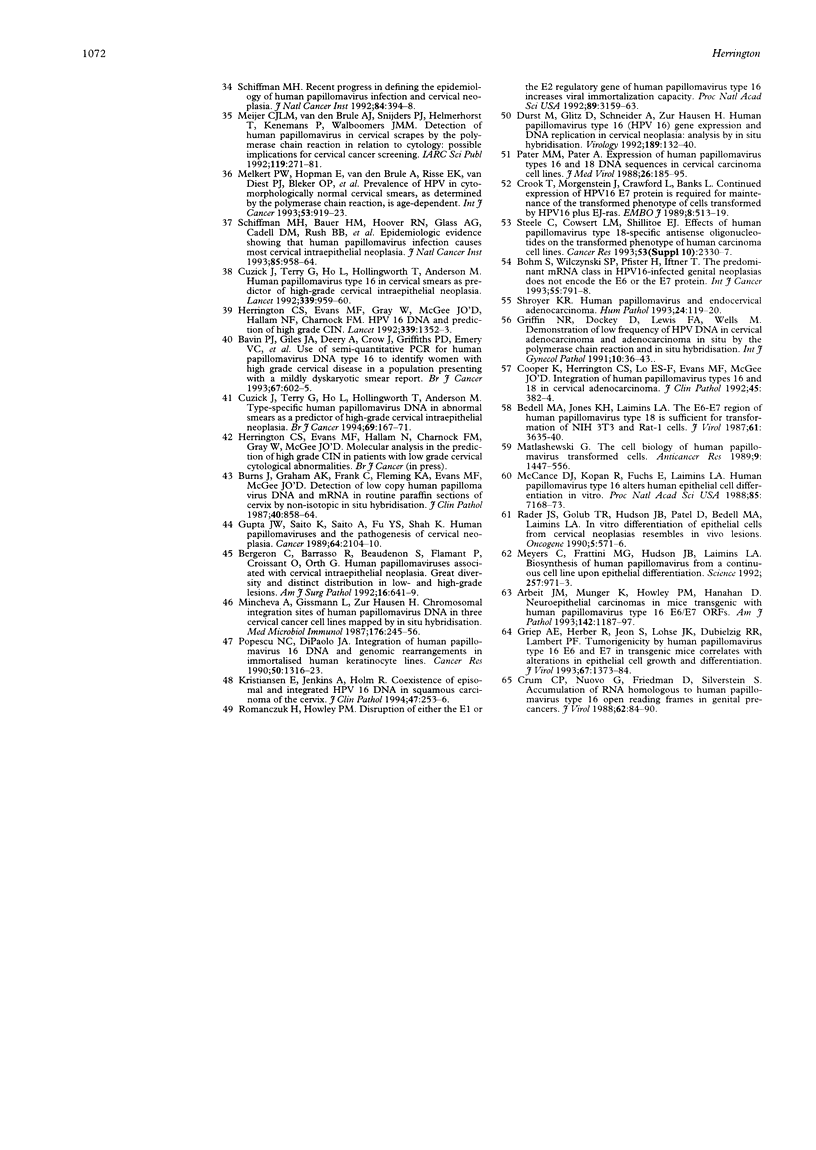
Images in this article
Selected References
These references are in PubMed. This may not be the complete list of references from this article.
- Arbeit J. M., Münger K., Howley P. M., Hanahan D. Neuroepithelial carcinomas in mice transgenic with human papillomavirus type 16 E6/E7 ORFs. Am J Pathol. 1993 Apr;142(4):1187–1197. [PMC free article] [PubMed] [Google Scholar]
- Bavin P. J., Giles J. A., Deery A., Crow J., Griffiths P. D., Emery V. C., Walker P. G. Use of semi-quantitative PCR for human papillomavirus DNA type 16 to identify women with high grade cervical disease in a population presenting with a mildly dyskaryotic smear report. Br J Cancer. 1993 Mar;67(3):602–605. doi: 10.1038/bjc.1993.110. [DOI] [PMC free article] [PubMed] [Google Scholar]
- Bedell M. A., Jones K. H., Laimins L. A. The E6-E7 region of human papillomavirus type 18 is sufficient for transformation of NIH 3T3 and rat-1 cells. J Virol. 1987 Nov;61(11):3635–3640. doi: 10.1128/jvi.61.11.3635-3640.1987. [DOI] [PMC free article] [PubMed] [Google Scholar]
- Bergeron C., Barrasso R., Beaudenon S., Flamant P., Croissant O., Orth G. Human papillomaviruses associated with cervical intraepithelial neoplasia. Great diversity and distinct distribution in low- and high-grade lesions. Am J Surg Pathol. 1992 Jul;16(7):641–649. doi: 10.1097/00000478-199207000-00002. [DOI] [PubMed] [Google Scholar]
- Brinton L. A. Epidemiology of cervical cancer--overview. IARC Sci Publ. 1992;(119):3–23. [PubMed] [Google Scholar]
- Burns J., Graham A. K., Frank C., Fleming K. A., Evans M. F., McGee J. O. Detection of low copy human papilloma virus DNA and mRNA in routine paraffin sections of cervix by non-isotopic in situ hybridisation. J Clin Pathol. 1987 Aug;40(8):858–864. doi: 10.1136/jcp.40.8.858. [DOI] [PMC free article] [PubMed] [Google Scholar]
- Böhm S., Wilczynski S. P., Pfister H., Iftner T. The predominant mRNA class in HPV16-infected genital neoplasias does not encode the E6 or the E7 protein. Int J Cancer. 1993 Nov 11;55(5):791–798. doi: 10.1002/ijc.2910550517. [DOI] [PubMed] [Google Scholar]
- Cooper K., Herrington C. S., Lo E. S., Evans M. F., McGee J. O. Integration of human papillomavirus types 16 and 18 in cervical adenocarcinoma. J Clin Pathol. 1992 May;45(5):382–384. doi: 10.1136/jcp.45.5.382. [DOI] [PMC free article] [PubMed] [Google Scholar]
- Cooper K., Herrington C. S., Stickland J. E., Evans M. F., McGee J. O. Episomal and integrated human papillomavirus in cervical neoplasia shown by non-isotopic in situ hybridisation. J Clin Pathol. 1991 Dec;44(12):990–996. doi: 10.1136/jcp.44.12.990. [DOI] [PMC free article] [PubMed] [Google Scholar]
- Crook T., Morgenstern J. P., Crawford L., Banks L. Continued expression of HPV-16 E7 protein is required for maintenance of the transformed phenotype of cells co-transformed by HPV-16 plus EJ-ras. EMBO J. 1989 Feb;8(2):513–519. doi: 10.1002/j.1460-2075.1989.tb03405.x. [DOI] [PMC free article] [PubMed] [Google Scholar]
- Crum C. P., Nuovo G., Friedman D., Silverstein S. J. Accumulation of RNA homologous to human papillomavirus type 16 open reading frames in genital precancers. J Virol. 1988 Jan;62(1):84–90. doi: 10.1128/jvi.62.1.84-90.1988. [DOI] [PMC free article] [PubMed] [Google Scholar]
- Cullen A. P., Reid R., Campion M., Lörincz A. T. Analysis of the physical state of different human papillomavirus DNAs in intraepithelial and invasive cervical neoplasm. J Virol. 1991 Feb;65(2):606–612. doi: 10.1128/jvi.65.2.606-612.1991. [DOI] [PMC free article] [PubMed] [Google Scholar]
- Cuzick J., Terry G., Ho L., Hollingworth T., Anderson M. Human papillomavirus type 16 in cervical smears as predictor of high-grade cervical intraepithelial neoplasia [corrected]. Lancet. 1992 Apr 18;339(8799):959–960. doi: 10.1016/0140-6736(92)91532-d. [DOI] [PubMed] [Google Scholar]
- Cuzick J., Terry G., Ho L., Hollingworth T., Anderson M. Type-specific human papillomavirus DNA in abnormal smears as a predictor of high-grade cervical intraepithelial neoplasia. Br J Cancer. 1994 Jan;69(1):167–171. doi: 10.1038/bjc.1994.28. [DOI] [PMC free article] [PubMed] [Google Scholar]
- Dürst M., Glitz D., Schneider A., zur Hausen H. Human papillomavirus type 16 (HPV 16) gene expression and DNA replication in cervical neoplasia: analysis by in situ hybridization. Virology. 1992 Jul;189(1):132–140. doi: 10.1016/0042-6822(92)90688-l. [DOI] [PubMed] [Google Scholar]
- Falcinelli C., van Belkum A., Schrauwen L., Seldenrijk K., Quint W. G. Absence of human papillomavirus type 16 E6 transcripts in HPV 16-infected, cytologically normal cervical scrapings. J Med Virol. 1993 Aug;40(4):261–265. doi: 10.1002/jmv.1890400402. [DOI] [PubMed] [Google Scholar]
- Farnsworth A., Laverty C., Stoler M. H. Human papillomavirus messenger RNA expression in adenocarcinoma in situ of the uterine cervix. Int J Gynecol Pathol. 1989;8(4):321–330. doi: 10.1097/00004347-198912000-00003. [DOI] [PubMed] [Google Scholar]
- Farthing A., Masterson P., Mason W. P., Vousden K. H. Human papillomavirus detection by hybrid capture and its possible clinical use. J Clin Pathol. 1994 Jul;47(7):649–652. doi: 10.1136/jcp.47.7.649. [DOI] [PMC free article] [PubMed] [Google Scholar]
- Griep A. E., Herber R., Jeon S., Lohse J. K., Dubielzig R. R., Lambert P. F. Tumorigenicity by human papillomavirus type 16 E6 and E7 in transgenic mice correlates with alterations in epithelial cell growth and differentiation. J Virol. 1993 Mar;67(3):1373–1384. doi: 10.1128/jvi.67.3.1373-1384.1993. [DOI] [PMC free article] [PubMed] [Google Scholar]
- Griffin N. R., Dockey D., Lewis F. A., Wells M. Demonstration of low frequency of human papillomavirus DNA in cervical adenocarcinoma and adenocarcinoma in situ by the polymerase chain reaction and in situ hybridization. Int J Gynecol Pathol. 1991;10(1):36–43. doi: 10.1097/00004347-199101000-00004. [DOI] [PubMed] [Google Scholar]
- Gupta J. W., Saito K., Saito A., Fu Y. S., Shah K. V. Human papillomaviruses and the pathogenesis of cervical neoplasia. A study by in situ hybridization. Cancer. 1989 Nov 15;64(10):2104–2110. doi: 10.1002/1097-0142(19891115)64:10<2104::aid-cncr2820641022>3.0.co;2-n. [DOI] [PubMed] [Google Scholar]
- Herrington C. S., Evans M. F., Gray W., McGee J. O., Hallam N., Charnock F. M. HPV16 DNA and prediction of high-grade CIN. Lancet. 1992 May 30;339(8805):1352–1353. doi: 10.1016/0140-6736(92)91995-k. [DOI] [PubMed] [Google Scholar]
- Herrington C. S., de Angelis M., Evans M. F., Troncone G., McGee J. O. Detection of high risk human papillomavirus in routine cervical smears: strategy for screening. J Clin Pathol. 1992 May;45(5):385–390. doi: 10.1136/jcp.45.5.385. [DOI] [PMC free article] [PubMed] [Google Scholar]
- Ho L., Chan S. Y., Burk R. D., Das B. C., Fujinaga K., Icenogle J. P., Kahn T., Kiviat N., Lancaster W., Mavromara-Nazos P. The genetic drift of human papillomavirus type 16 is a means of reconstructing prehistoric viral spread and the movement of ancient human populations. J Virol. 1993 Nov;67(11):6413–6423. doi: 10.1128/jvi.67.11.6413-6423.1993. [DOI] [PMC free article] [PubMed] [Google Scholar]
- Ho L., Tay S. K., Chan S. Y., Bernard H. U. Sequence variants of human papillomavirus type 16 from couples suggest sexual transmission with low infectivity and polyclonality in genital neoplasia. J Infect Dis. 1993 Oct;168(4):803–809. doi: 10.1093/infdis/168.4.803. [DOI] [PubMed] [Google Scholar]
- Kataja V., Syrjänen S., Mäntyjärvi R., Yliskoski M., Saarikoski S., Syrjänen K. Prognostic factors in cervical human papillomavirus infections. Sex Transm Dis. 1992 May-Jun;19(3):154–160. doi: 10.1097/00007435-199205000-00009. [DOI] [PubMed] [Google Scholar]
- Kataja V., Syrjänen S., Yliskoski M., Hippelïnen M., Väyrynen M., Saarikoski S., Mäntyjärvi R., Jokela V., Salonen J. T., Syrjänen K. Risk factors associated with cervical human papillomavirus infections: a case-control study. Am J Epidemiol. 1993 Nov 1;138(9):735–745. doi: 10.1093/oxfordjournals.aje.a116911. [DOI] [PubMed] [Google Scholar]
- Koutsky L. A., Holmes K. K., Critchlow C. W., Stevens C. E., Paavonen J., Beckmann A. M., DeRouen T. A., Galloway D. A., Vernon D., Kiviat N. B. A cohort study of the risk of cervical intraepithelial neoplasia grade 2 or 3 in relation to papillomavirus infection. N Engl J Med. 1992 Oct 29;327(18):1272–1278. doi: 10.1056/NEJM199210293271804. [DOI] [PubMed] [Google Scholar]
- Kristiansen E., Jenkins A., Holm R. Coexistence of episomal and integrated HPV16 DNA in squamous cell carcinoma of the cervix. J Clin Pathol. 1994 Mar;47(3):253–256. doi: 10.1136/jcp.47.3.253. [DOI] [PMC free article] [PubMed] [Google Scholar]
- Lorincz A. T., Reid R., Jenson A. B., Greenberg M. D., Lancaster W., Kurman R. J. Human papillomavirus infection of the cervix: relative risk associations of 15 common anogenital types. Obstet Gynecol. 1992 Mar;79(3):328–337. doi: 10.1097/00006250-199203000-00002. [DOI] [PubMed] [Google Scholar]
- Matlashewski G. The cell biology of human papillomavirus transformed cells. Anticancer Res. 1989 Sep-Oct;9(5):1447–1456. [PubMed] [Google Scholar]
- McLachlin C. M., Tate J. E., Zitz J. C., Sheets E. E., Crum C. P. Human papillomavirus type 18 and intraepithelial lesions of the cervix. Am J Pathol. 1994 Jan;144(1):141–147. [PMC free article] [PubMed] [Google Scholar]
- Meijer C. J., van den Brule A. J., Snijders P. J., Helmerhorst T., Kenemans P., Walboomers J. M. Detection of human papillomavirus in cervical scrapes by the polymerase chain reaction in relation to cytology: possible implications for cervical cancer screening. IARC Sci Publ. 1992;(119):271–281. [PubMed] [Google Scholar]
- Melkert P. W., Hopman E., van den Brule A. J., Risse E. K., van Diest P. J., Bleker O. P., Helmerhorst T., Schipper M. E., Meijer C. J., Walboomers J. M. Prevalence of HPV in cytomorphologically normal cervical smears, as determined by the polymerase chain reaction, is age-dependent. Int J Cancer. 1993 Apr 1;53(6):919–923. doi: 10.1002/ijc.2910530609. [DOI] [PubMed] [Google Scholar]
- Meyers C., Frattini M. G., Hudson J. B., Laimins L. A. Biosynthesis of human papillomavirus from a continuous cell line upon epithelial differentiation. Science. 1992 Aug 14;257(5072):971–973. doi: 10.1126/science.1323879. [DOI] [PubMed] [Google Scholar]
- Mincheva A., Gissmann L., zur Hausen H. Chromosomal integration sites of human papillomavirus DNA in three cervical cancer cell lines mapped by in situ hybridization. Med Microbiol Immunol. 1987;176(5):245–256. doi: 10.1007/BF00190531. [DOI] [PubMed] [Google Scholar]
- Mitchell H., Drake M., Medley G. Prospective evaluation of risk of cervical cancer after cytological evidence of human papilloma virus infection. Lancet. 1986 Mar 15;1(8481):573–575. doi: 10.1016/s0140-6736(86)92807-2. [DOI] [PubMed] [Google Scholar]
- Münger K., Phelps W. C. The human papillomavirus E7 protein as a transforming and transactivating factor. Biochim Biophys Acta. 1993 May 25;1155(1):111–123. doi: 10.1016/0304-419x(93)90025-8. [DOI] [PubMed] [Google Scholar]
- Pater M. M., Pater A. Expression of human papillomavirus types 16 and 18 DNA sequences in cervical carcinoma cell lines. J Med Virol. 1988 Oct;26(2):185–195. doi: 10.1002/jmv.1890260210. [DOI] [PubMed] [Google Scholar]
- Popescu N. C., DiPaolo J. A. Integration of human papillomavirus 16 DNA and genomic rearrangements in immortalized human keratinocyte lines. Cancer Res. 1990 Feb 15;50(4):1316–1323. [PubMed] [Google Scholar]
- Rader J. S., Golub T. R., Hudson J. B., Patel D., Bedell M. A., Laimins L. A. In vitro differentiation of epithelial cells from cervical neoplasias resembles in vivo lesions. Oncogene. 1990 Apr;5(4):571–576. [PubMed] [Google Scholar]
- Robertson D. I., Maung R., Duggan M. A. Verrucous carcinoma of the genital tract: is it a distinct entity? Can J Surg. 1993 Apr;36(2):147–151. [PubMed] [Google Scholar]
- Romanczuk H., Howley P. M. Disruption of either the E1 or the E2 regulatory gene of human papillomavirus type 16 increases viral immortalization capacity. Proc Natl Acad Sci U S A. 1992 Apr 1;89(7):3159–3163. doi: 10.1073/pnas.89.7.3159. [DOI] [PMC free article] [PubMed] [Google Scholar]
- Schiffman M. H., Bauer H. M., Hoover R. N., Glass A. G., Cadell D. M., Rush B. B., Scott D. R., Sherman M. E., Kurman R. J., Wacholder S. Epidemiologic evidence showing that human papillomavirus infection causes most cervical intraepithelial neoplasia. J Natl Cancer Inst. 1993 Jun 16;85(12):958–964. doi: 10.1093/jnci/85.12.958. [DOI] [PubMed] [Google Scholar]
- Schiffman M. H. Recent progress in defining the epidemiology of human papillomavirus infection and cervical neoplasia. J Natl Cancer Inst. 1992 Mar 18;84(6):394–398. doi: 10.1093/jnci/84.6.394. [DOI] [PubMed] [Google Scholar]
- Schneider A., Koutsky L. A. Natural history and epidemiological features of genital HPV infection. IARC Sci Publ. 1992;(119):25–52. [PubMed] [Google Scholar]
- Steele C., Cowsert L. M., Shillitoe E. J. Effects of human papillomavirus type 18-specific antisense oligonucleotides on the transformed phenotype of human carcinoma cell lines. Cancer Res. 1993 May 15;53(10 Suppl):2330–2337. [PubMed] [Google Scholar]
- Stoler M. H., Rhodes C. R., Whitbeck A., Wolinsky S. M., Chow L. T., Broker T. R. Human papillomavirus type 16 and 18 gene expression in cervical neoplasias. Hum Pathol. 1992 Feb;23(2):117–128. doi: 10.1016/0046-8177(92)90232-r. [DOI] [PubMed] [Google Scholar]
- Storey A., Greenfield I., Banks L., Pim D., Crook T., Crawford L., Stanley M. Lack of immortalizing activity of a human papillomavirus type 16 variant DNA with a mutation in the E2 gene isolated from normal human cervical keratinocytes. Oncogene. 1992 Mar;7(3):459–465. [PubMed] [Google Scholar]
- Syrjänen K., de Villiers E. M., Saarikoski S., Castren O., Väyrynen M., Mäntyjärvi R., Parkkinen S. Cervical papillomavirus infection progressing to invasive cancer in less than three years. Lancet. 1985 Mar 2;1(8427):510–511. doi: 10.1016/s0140-6736(85)92102-6. [DOI] [PubMed] [Google Scholar]
- Wilczynski S. P., Oft M., Cook N., Liao S. Y., Iftner T. Human papillomavirus type 6 in squamous cell carcinoma of the bladder and cervix. Hum Pathol. 1993 Jan;24(1):96–102. doi: 10.1016/0046-8177(93)90068-r. [DOI] [PubMed] [Google Scholar]
- Xi L. F., Demers W., Kiviat N. B., Kuypers J., Beckmann A. M., Galloway D. A. Sequence variation in the noncoding region of human papillomavirus type 16 detected by single-strand conformation polymorphism analysis. J Infect Dis. 1993 Sep;168(3):610–617. doi: 10.1093/infdis/168.3.610. [DOI] [PubMed] [Google Scholar]
- de Villiers E. M. Heterogeneity of the human papillomavirus group. J Virol. 1989 Nov;63(11):4898–4903. doi: 10.1128/jvi.63.11.4898-4903.1989. [DOI] [PMC free article] [PubMed] [Google Scholar]





